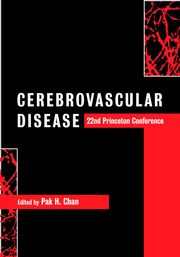Book contents
- Frontmatter
- Contents
- List of contributors
- Preface
- Acknowledgments
- Part I Special lectures
- Part II Oxidative stress
- Part III Apoptosis
- Part IV Hot topics
- Part V Hemorrhage, edema and secondary injury
- Part VI Inflammation
- Part VII Gene transfer and therapy
- Part VIII Neurogenesis and plasticity
- Part IX Magnetic resonance imaging in clinical stroke
- Part X Risk factors, clinical trials and new therapeutic horizons
- 32 Vascular factors in Alzheimer's disease
- 33 Beyond neuroprotection: the protection of axons and oligodendrocytes in cerebral ischemia
- 34 Combining neuroprotection with thrombolysis: how to translate laboratory success to our clinical trials
- 35 Prospects for improved neuroprotection trials in stroke
- 36 Basic research and stroke therapeutics: what have we learned?
- Index
- Plate section
33 - Beyond neuroprotection: the protection of axons and oligodendrocytes in cerebral ischemia
from Part X - Risk factors, clinical trials and new therapeutic horizons
Published online by Cambridge University Press: 02 November 2009
- Frontmatter
- Contents
- List of contributors
- Preface
- Acknowledgments
- Part I Special lectures
- Part II Oxidative stress
- Part III Apoptosis
- Part IV Hot topics
- Part V Hemorrhage, edema and secondary injury
- Part VI Inflammation
- Part VII Gene transfer and therapy
- Part VIII Neurogenesis and plasticity
- Part IX Magnetic resonance imaging in clinical stroke
- Part X Risk factors, clinical trials and new therapeutic horizons
- 32 Vascular factors in Alzheimer's disease
- 33 Beyond neuroprotection: the protection of axons and oligodendrocytes in cerebral ischemia
- 34 Combining neuroprotection with thrombolysis: how to translate laboratory success to our clinical trials
- 35 Prospects for improved neuroprotection trials in stroke
- 36 Basic research and stroke therapeutics: what have we learned?
- Index
- Plate section
Summary
Neuroprotection and anti-ischemic drug development
A decade ago, there was little compelling evidence that pharmacological intervention could radically alter outcome after cerebral ischemia, even in experimental animals. By 1996, the pace of advance was such that a large number of drugs targeted at neurotransmitter receptors, and related mechanisms involved in ischemic damage, had advanced to clinical trials in stroke and head injury. The transformation of the pharmacology of cerebral ischemia had been achieved for two major reasons: first, the elucidation of neurochemical cascades initiated by ischemia, which revealed potential targets for intervention; and, second, the systematic assessment of drug efficacy using robust end-points (quantitative histopathology) in the most pertinent animal models. Since the elucidation of the excitotoxic cascade, numerous other pathological mechanisms have been identified by which neuroprotection can be achieved in ischemia. However, excitotoxicity remains central to current concepts of neuronal cell death and provides the prototype for anti-ischemic drug development for new pharmacological targets, i.e., reduction of the volume of neuronal perikaryal damage in models of focal cerebral ischemia.
Animal models of focal cerebral ischemia are generally recognized as the most pertinent in relation to human stroke. The most widely used models of focal cerebral ischemia involve occlusion of the middle cerebral artery (MCA) either by surgical division or intraluminal suture placement.
- Type
- Chapter
- Information
- Cerebrovascular Disease22nd Princeton Conference, pp. 404 - 415Publisher: Cambridge University PressPrint publication year: 2002
- 1
- Cited by



